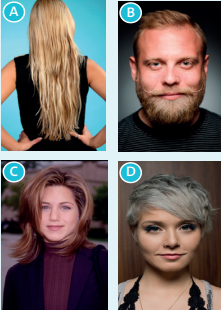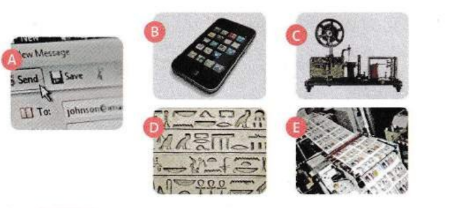1. Look at the photos. Then read the article. Which photo(s) match(es) each decade?
(Nhìn vào các bức ảnh. Sau đó đọc bài viết. (Những) bức ảnh nào phù hợp với mỗi thập kỷ?)

Hair through the decades
Like fashion trends, hairstyles come and go. Here’s a look at hair crazes over the past thirty years.
1990s - The ‘Rachel’
This hairstyle was named after Rachel Green, a character from the 1990s American sitcom Friends. The actress Jennifer Aniston, who played Rachel in the show, used to have medium-length hair that was cut in layers at the bottom.
2000s - Extensions
The craze for very long, straight hair in the first decade of the 21st century made hair extensions extremely popular.
2010s
Grey hair
This decade introduced a strange new fashion of young women with grey hair. Not natural grey hair, but a dye to change the colour to silver grey.
The beard and the moustache
OK, so they’re not really hairstyles, but the long beard and curly moustache will be remembered as the look of the 2010s. They were so popular that images of moustaches even decorated blouses, hats and all sorts of clothes.
Hair through the decades
Like fashion trends, hairstyles come and go. Here’s a look at hair crazes over the past thirty years.
(Tóc qua nhiều thập kỷ
Giống như xu hướng thời trang, kiểu tóc đến rồi đi. Đây là một cái nhìn về những cơn sốt tóc trong ba mươi năm qua.)
1990s – Photo C
1990s - The ‘Rachel’
This hairstyle was named after Rachel Green, a character from the 1990s American sitcom Friends. The actress Jennifer Aniston, who played Rachel in the show, used to have medium-length hair that was cut in layers at the bottom.
(Những năm 1990 - 'Rachel'
Kiểu tóc này được đặt tên theo Rachel Green, một nhân vật trong bộ phim sitcom Friends của Mỹ những năm 1990. Nữ diễn viên Jennifer Aniston, người đóng vai Rachel trong phim, từng có mái tóc dài vừa phải được cắt thành nhiều lớp ở phía dưới.)
2000s – Photo A
2000s - Extensions
The craze for very long, straight hair in the first decade of the 21st century made hair extensions extremely popular.
(Những năm 2000 – Tóc nối
Cơn sốt tóc thẳng, dài trong thập kỷ đầu tiên của thế kỷ 21 khiến tóc nối trở nên cực kỳ phổ biến.)
2010s – Photo B & D
2010s
Grey hair
This decade introduced a strange new fashion of young women with grey hair. Not natural grey hair, but a dye to change the colour to silver grey.
The beard and the moustache
OK, so they’re not really hairstyles, but the long beard and curly moustache will be remembered as the look of the 2010s. They were so popular that images of moustaches even decorated blouses, hats and all sorts of clothes.
(Những năm 2010
Tóc màu xám
Thập kỷ này giới thiệu một thời trang mới kỳ lạ của phụ nữ trẻ với mái tóc hoa râm. Không phải tóc bạc tự nhiên mà là thuốc nhuộm để chuyển sang màu xám bạc.
Râu và ria mép
OK, chúng không thực sự là kiểu tóc, nhưng bộ râu dài và ria mép xoăn sẽ được nhớ đến như kiểu tóc của những năm 2010. Chúng phổ biến đến mức hình ảnh những bộ ria mép thậm chí còn được trang trí trên áo cánh, mũ và đủ loại quần áo.)

Các bài tập cùng chuyên đề
1. Read the interview with an expert on crazes. What is the purpose of the article?
(Đọc cuộc phỏng vấn với một chuyên gia về cơn sốt. Mục đích của bài viết là gì?)
a. to give information
(đưa ra thông tin)
b. to sell digital products
(bán những sản phẩm kỹ thuật số)
c. to help people start a new craze
(giúp mọi người bắt đầu một cơn sốt mới)
CRAZY CRAZES
An interview with Miley Jones, an expert on the history of crazes.
HOW DO CRAZES START?
Well, crazes generally start in the playground when we're young. We see someone doing something fun and obviously we want to join them.
WHAT WAS THE STRANGEST CRAZE?
Pole-sitting, probably. In 1924, Alvin Kelly sat on a pole for thirteen hours. Amazingly, it became popular, and people used to watch the best pole-sitters. The record was twenty-one days.
HOW DO CURRENT CRAZES DIFFER FROM PAST CRAZES?
Things like toys and card-collecting used to be popular. Now crazes often start online, when people see and copy funny ideas for photos or videos on social media.
IS THAT HOW CRAZES BECOME SO POPULAR QUICKLY?
Absolutely! Things can quickly become a craze. Before, people didn't use to have smartphones, but now we can post online games scores or photos immediately.
WHAT'S YOUR FAVOURITE CRAZE?
Pet rocks. In the 1970s, Gary Dahl started selling a pet rock in a special box with instructions.
DID PEOPLE REALLY USE TO BUY PET ROCKS?
Yes, they did. Apparently, he sold millions of them. No one really knows what the next craze will be.
2. Read and listen to the interview again. Write questions for answers 1-5.
(Đọc và nghe lại cuộc phỏng vấn. Viết câu hỏi cho câu trả lời 1-5.)
1. In 1924. (When____________?)
2. For thirteen hours. (For how long____________?)
3. On social media. (Where_______________?)
4. He sold pet rocks. (What____________?)
5. Millions. (How many________________?)
1. Read the fact file. What things were popular in the eighties? Work in pairs. Tell your partner what was popular in the eighties using the phrases.
(Đọc tài liệu thực tế. Những điều gì đã phổ biến trong thập niên tám mươi? Làm việc theo cặp. Nói với bạn của bạn những gì phổ biến trong thập niên tám mươi cách sử dụng các cụm từ.)
Fads and fashions of the eighties in Việt Nam
FASHION
During this decade, the most common outfit for Vietnamese people was a loose shirt and flared trousers. Especially, rich girls used to wear shirts with lotus collars or vintage dresses.
MUSIC
The eighties was the decade when Vietnamese pop music developed. The songs of musicians like Nguyễn Ngọc Thiện and Nguyễn Văn Tỷ praised a new life. For example, Ơi Cuộc Sống Mến Thương and Bài Ca Năm Tấn were about the nation building.
TECHNOLOGY
At that time technology was more basic. Television started to become popular in the 1980s, but people only had black-and-white TVs, for instance.
CRAZES
There were crazes for fun things, such as tug of war, bamboo jacks and blind man's buff. In those days, they were a massive trend for teenagers.
|
KEY PHRASES (Cụm từ khóa) Describing a specific time period in the past (Diễn tả một khoảng thời gian cụ thể trong quá khứ) In the (eighties), ... (Trong (thập niên tám mươi), …) It was the decade when ... (Đó là thập kỷ khi mà….) In those days, ... (Trong những ngày ấy, …) At that time, ... (Vào thời đó, …..) During this decade / era, ... (Trong suốt thập kỷ / thời đại này, ….) |
2. Read and listen to the article again and answer the questions.
(Đọc và nghe lại bài viết và trả lời những câu hỏi.)
1. Why was a hairstyle called ‘the Rachel’?
2. What did the hairstyle in the 2000s look like?
3. What new hair colour became popular in the 2010s?
3. YOUR CULTURE - Work in pairs. Answer the questions about Việt Nam.
(Làm việc theo cặp. Trả lời các câu hỏi về Việt Nam.)
1. Which hairstyles are most popular in Việt Nam at the moment?
(Kiểu tóc nào đang thịnh hành nhất ở Việt Nam hiện nay?)
2. Which of the following are fashionable for men in Việt Nam?
(Cái nào sau đây là thời trang cho nam giới ở Việt Nam?)

(râu tóc dài ria mép undercut)
3. What colour hair dye is the most popular in Việt Nam?
(Màu tóc nhuộm nào thịnh hành nhất Việt Nam?)

(đen vàng nâu xám đỏ khác)
1 Read and listen to the timeline. Choose the correct answer.
(Đọc và nghe dòng thời gian. Chọn câu trả lời đúng.)
The main purpose of the timeline is … . (Mục đích chính của dòng thời gian là …)
a to tell us the best ways to communicate (cho chúng tôi biết những cách giao tiếp tốt nhất)
b to explain the history of communication (để giải thích lịch sử truyền thông)
c to give recent news about technology (để cung cấp tin tức gần đây về công nghệ)
Communication through time
A Why is language so important? Well, it's part of what makes us human! We are the only species on Earth that can share our thoughts and ideas through language.
And our history shows how we are always looking for new ways to communicate ...
B Early human language was a spoken form of communication. Around 40,000 years ago, there were cave paintings and then much later, around 5,500 years ago, people started creating picture- writing systems, such as Egyptian hieroglyphs. The alphabets we use today developed after this, over thousands of years.
C Until the 15th century, people copied books by hand. Obviously, this was a very slow process. With the invention of the printing press, all of this changed. In 1440, it became possible to copy books easily and quickly, and many more people learned to read.
D Sending personal messages was still slow for a few hundred years. It used to take weeks for letters to arrive. In the 1830s, electric telegraph services started for short messages. By the early 20th century, the telephone made it possible to communicate spoken words over long distances. Email, the internet and mobile phones became popular in the 1990s.
E Today, we communicate with people all over the world using gadgets. We use text messages, video calls and chat and picture apps like WhatsApp and Instagram. In an age of easy, instant messaging, it's hard to imagine how difficult communication used to be.
2 Read the timeline again. Choose the correct words to describe each paragraph.
(Đọc lại dòng thời gian. Chọn những từ thích hợp để mô tả mỗi đoạn văn.)
A why human communication is special / difficult / scientific (tại sao giao tiếp của con người là đặc biệt / khó khăn / khoa học)
B the slowest / earliest / best forms of communication (hình thức giao tiếp chậm nhất/sớm nhất/tốt nhất)
C the beginning / end / cost of printing (đầu / cuối / chi phí in ấn)
D inventions over the last ten / 100 / 200 years (phát minh trong mười / 100 / 200 năm qua)
E elcetronics / life / communication today (điện tử / đời sống / truyền thông ngày nay)
3 Match sentences 1 – 5 with photos A – E.
(Nối câu 1 – 5 với ảnh A – E.)

1 It was very different from modern writing. …D…
(Nó rất khác với chữ viết hiện đại.)
2 It made it quicler and easier to copy texts.
(Nó làm cho việc sao chép văn bản nhanh hơn và dễ dàng hơn.)
3 It was first technology for instant messaging.
(Đó là công nghệ đầu tiên cho tin nhắn nhanh.)
4 It became common with the internet.
(Nó trở nên phổ biến với internet.)
5 It lets you speak to people from a distance.
(Nó cho phép bạn nói chuyện với mọi người từ xa.)






